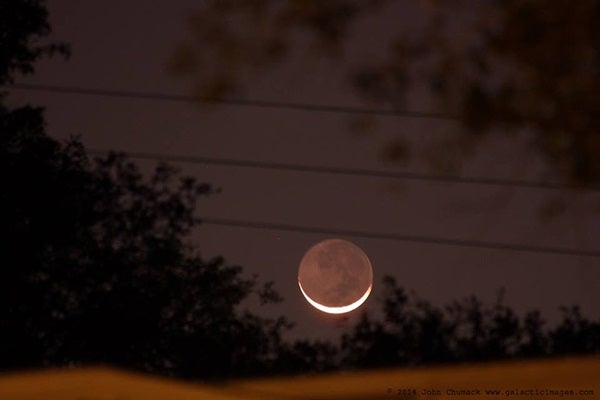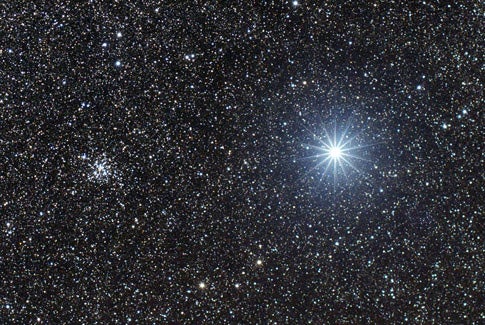Two of the finest deep-sky objects shine prominently on February evenings. The Pleiades and Hyades star clusters appear highest in the south in early evening but remain conspicuous until well past midnight. The Pleiades, also known at the Seven Sisters and M45, looks like a small dipper to the naked eye. The larger Hyades forms the V-shaped head of Taurus the Bull. Although both look nice without optical aid, binoculars show them best.
Saturday, February 2
Saturn passed on the opposite side of the Sun from Earth exactly one month ago, but it already appears low in the southeast during morning twilight. From mid-northern latitudes, the ringed planet rises about 90 minutes before the Sun and climbs 10° above the horizon a half-hour before sunup. Saturn shines at magnitude 0.6 and should be fairly easy to pick out of the twilight. The waning crescent Moon makes the task even easier this morning. Its 5-percent-lit crescent appears 3° to the ringed planet’s lower left. Simply center the Moon through binoculars and look for the bright point of light near the field’s upper right edge.
For those who believe in folklore, the fate of winter rests on the shoulders of the groundhog. If the furry rodent sticks his head out of his burrow this morning and sees his shadow, we’ll have six more weeks of winter. But if the weather is cloudy, it means spring is right around the corner. What does this have to do with astronomy? Groundhog Day celebrates one of the four so-called cross-quarter days, which mark the midpoints between the solstices and equinoxes. February 2 falls approximately midway between the winter solstice and the vernal equinox.
Sunday, February 3
The variable star Algol in Perseus appears faintest at 11:55 p.m. EST, when it shines at magnitude 3.4. If you start watching it immediately after darkness falls, you can see it dim from its peak brightness (magnitude 2.1) to minimum and then start brightening again. This eclipsing binary star runs through a cycle from minimum to maximum and back every 2.87 days, but the drop from peak brightness and subsequent rise lasts only about 10 hours. Algol appears nearly overhead soon after darkness falls and descends toward the northwestern horizon well after midnight.
Monday, February 4
Venus appears brilliant in the southeast before dawn. It reached greatest western elongation a month ago and continues to dominate the predawn sky. The inner world shines at magnitude –4.3, some 10 times brighter than the second-brightest planet, Jupiter. Venus rises nearly three hours before the Sun and stands 15° high an hour before sunup. The planet lies among the background stars of Sagittarius, close to two of the Milky Way’s finest deep-sky objects. This morning, the Trifid Nebula (M20) lies 2° due south of the planet and the Lagoon Nebula (M8) appears 1.5° farther south. Through a telescope, Venus shows a disk that spans 19″ and appears nearly two-thirds lit.
New Moon occurs at 4:04 p.m. EST. At its New phase, the Moon crosses the sky with the Sun and so remains hidden in our star’s glare.
Tuesday, February 5
One of the sky’s largest asterisms — a recognizable pattern of stars separate from a constellation’s form — occupies center stage on February evenings. To trace the so-called Winter Hexagon, start with southern Orion’s luminary, Rigel. From there, the hexagon makes a clockwise loop. The second stop is brilliant Sirius in Canis Major. Next, pick up Procyon in the faint constellation Canis Minor, then the twins Castor and Pollux in Gemini, followed by Capella in Auriga, Aldebaran in Taurus, and finally back to Rigel.
The Moon reaches apogee, the farthest point in its orbit around Earth, at 4:29 a.m. EST. It then lies 252,622 miles (406,555 kilometers) from Earth’s center.
A young crescent Moon hung low in the west as this photographer snapped its image. He noted that he barely got it amid the house’s roof, the trees, the power lines, and the hazy conditions near the horizon. Skygazers have an excellent chance to see a similarly slim crescent Moon the evening of February 6.
Although the Moon reached its New phase just two days ago, its rapid orbital motion carries it into view after the Sun goes down this evening. Look low in the west-southwest about an hour after sunset and you’ll see its 4-percent-lit crescent hanging in the twilight like the smile of the Cheshire Cat.
Thursday, February 7
Jupiter continues to grow more prominent in the southeastern sky before dawn. The giant planet rises nearly four hours before our star and climbs 20° high by the first hint of twilight. Jupiter gleams at magnitude –1.9, though it still pales in comparison to Venus, which rises an hour after the giant world. A telescope reveals Jupiter’s 34″-diameter disk and at least two conspicuous cloud belts.
Friday, February 8
For those of you in the Southern Hemisphere, today marks the peak of the annual Alpha Centaurid meteor shower. And with the Moon out of the sky, viewing conditions should be near perfect from late evening until morning twilight begins. The shower’s radiant — the point from which the meteors appear to originate — lies among the background stars of Centaurus (although, oddly enough, closer to 1st-magnitude Beta [β] Centauri than to its brighter neighbor, Alpha [α] Centauri). The shower typically produces about 6 meteors per hour at its peak, although observers have reported between 20 and 30 per hour in a couple of years. The meteors tend to be bright and often leave persistent trains.
Brilliant Sirius A appears overexposed at the center of this Hubble Space Telescope image. Look carefully to the star’s lower left, however, and you’ll pick up the faint glow of Sirius B. This white dwarf contains roughly the mass of the Sun squeezed into a sphere no larger than Earth.
The brightest star in the night sky puts on a nice show on February evenings. Gleaming at magnitude –1.5, Sirius shines nearly four times brighter than the next brightest star visible from mid-northern latitudes: Arcturus in the constellation Boötes. Sirius appears in the southeastern sky around 7 p.m. local time and climbs highest in the south around 9:30 p.m.
Sunday, February 10
Mars continues to shine brightly on February evenings. Look for the Red Planet halfway to the zenith in the southwestern sky as darkness falls. The world glows at magnitude 1.0 against the much dimmer stars of Pisces the Fish. Tonight, Mars sits 6° to the right of the waxing crescent Moon. A telescope reveals the planet’s 6″-diameter disk, but you likely won’t see any surface details.
Brilliant Venus continues its eastward march across the star-studded backdrop of Sagittarius. Both this morning and tomorrow morning, open star cluster M25 lies 2° north of the inner world and globular cluster M22 resides 3° south of the planet. All three objects fit nicely in the field of 7×50 binoculars.












